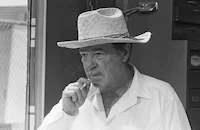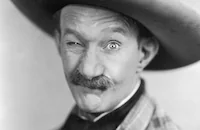Saps at Sea

Brief Synopsis
Cast & Crew
Gordon Douglas
Stan Laurel
Oliver Hardy
James Finlayson
Ben Turpin
Dick Cramer
Film Details
Technical Specs

Synopsis
While working at the Sharp and Pierce horn manufacturing company, Ollie develops a rare disease of the nervous system known as hornophobia. Ollie's case is so acute that it borders on hornomania, and as a result, whenever he hears a horn blow, he is imbued with a sense of superhuman strength. After examining Ollie, Dr. Finlayson prescribes a sea voyage and goats' milk, but the boys reject the idea and decide to compromise by buying a goat and renting a small boat, which they intend to leave tied to the dock. After they settle in for their first night at sea, their plans go awry when Nick Grainger, an escaped murderer and spy, stows away on board, and the goat eats the rope anchoring the boat to the dock, setting the craft adrift. Upon awakening the next morning, Stan and Ollie find themselves adrift in the middle of the ocean and at the mercy of a murderer. Knowing that the sound of a horn will turn Ollie into a strongman, Stan plays his trombone and Ollie subdues Grainger to Stan's accompaniment. The harbor patrol then comes to the rescue and arrests Grainger, but as Stan demonstrates how Ollie accomplished his miraculous feat, Ollie goes wild at the sound of the horn and the boys are led ashore in chains.

Director

Gordon Douglas
Cast

Stan Laurel

Oliver Hardy

James Finlayson
Ben Turpin
Dick Cramer
Harry Bernard
Eddie Conrad
Harry Hayden
Gene Morgan
Bob Mckenzie
Patsy Moran
Eddie Borden
Ernie Alexander
Francesca Santoro
Jackie Horner
Charles Hall
Carl Faulkner
Jack Green
C. A. Bachman
Bud Geary
Jack Hill
Walter Lawrence
Harry Evans
Mary Gordon
Patsy O'byrne
Wally O'connor
Allen Pomeroy
Jack Davidson
Jack Raymond
Bob Lafferty
Ed Brady
Bill Brady
John Hobart
Jack Lloyd
Vinegar Roan
Pat Mckay
Charles Stone
James Blount
Sam Lufkin
Jack Gamble
Johnny Woods
Chuck Callahan
Stella Curtis
Jack Perrin
Charles Regan
Tom Murray
Al Thompson
Harry Anderson
Byron Munson
Ed Shaeffer
Ted Henderson
Dix Davis
Crew
Felix Adler
Henry Alberti
Harry Black
Chet Brandenburg
Walter Brine
Frank Buckholtz
Hal Bumbaugh
Tony Campenero
Joseph Cascales
Collin Crietz
David Crocov
Harry Davis
W. B. Delaplain
Jos. Difiore
Ivan Eppinoff
Al Famulari
Lou Fieler
Lloyd Ford
Monty Ford
Norman Frazier
Freddie Glickman
Alex Golden
Charles D. Hall
Marvin Hartley
Ray Hoback
Gilbert Jaffy
Lucille Jones
Ray Kennedy
Joe Krector
Harry Langdon
Silvio Lavatelli
William Leavitt
Harold Lindoft
Art Lloyd
Lou Marcasie
Al Marineau
Ray Martinez
Francis Meyers
Hi Moulton
Enzo Pascarella
Charles Phillips
Gil Pratt
William Randall
Earl Rettig
Jack Reynolds
Earl Ritter
Hal Roach
Benton Roberts
Charles Rogers
Vincent De Rubertis
Roy Seawright
Henry Silk
Lou Singer
Jerome Spolidoro
Lee Stall
W. L. Stevens
Al Thompson
Eddie Walthen
Clinton Wardrop
Joe Yukl
William Ziegler

Film Details
Technical Specs

Articles
Saps at Sea
The action starts at the premises of the Sharp & Pierce Horn Manufacturing Co., where the boys are employed as testers, and Ollie is minutes away from becoming the cacophonous factory's latest industrial casualty. Finally snapping from the endless blare ("Horns to the right of me! Horns to the left of me! Horns all over me!"), the manic Hardy tosses his workspace (and his workmates) until the supervisor sends him home to relax. With the ministrations left to Stan's care, it goes exactly as well as can be expected, starting with the jamming of their car horn on the drive back.
Things get no saner at their apartment building, where the cockeyed super (silent clown Ben Turpin) has ensured that spigots activate the wrong faucets and gas jets out of electrical sockets. Hardy's doctor (Roach regular James Finlayson) diagnoses "hornophobia, on the verge of hornomania" and recommends an ocean voyage for his shot nerves. Ollie wants nothing to do with going out on the water, but Stan surprisingly offers a reasoned compromise for procuring sea air; rent a docked boat and live on it for a week. Of course, there's more trashing of the premises, including bumping Hardy out of a third-floor window, before the journey can proceed.
Fade to the docks, where the boys pipe themselves aboard the good ship Prickly Heat, Stanley dragging a live goat to address Finlayson's prescription of goat's milk. The jeopardy sets in that evening when escaped saboteur/murderer Nick Grainger (Richard Cramer), running from the authorities, ducks onto their boat to evade capture. Of course, the goat nibbles away the moorings, and Stan and Ollie awake to find themselves adrift and the impromptu houseboys to the dangerous thug. Their efforts to keep him at bay until the coast guard arrives, (including preparing him a "synthetic" meal out of the available household goods aboard), bring the film to its conclusion.
As the last L&H Roach film, Saps at Sea marked the final appearance of many with the boys for their perennial foil Finlayson, as well as for another regular, the diminutive Charlie Hall, here given little to do as the apartment concierge. The durable stock heavy Cramer, who had effectively menaced L&H in Scram! (1932), Pack Up Your Troubles (1932) and The Flying Deuces (1939), also made his last appearance with the team in a role that was crafted for him.
A bit of a mixed bag in comparison to Laurel and Hardy's other Roach features, Saps at Sea still offers its share of laughs, and stands as the final example of what the team could accomplish when allowed to improvise and fine-tune their gags, a luxury no longer afforded to them when they left their familiar berth for the constraints of working with the majors. "For the most part, these were poor and steadily worsening features, and Laurel & Hardy admirers were generally of the opinion that they should never have been made," William K. Everson opined of their post-Roach output in The Films of Laurel and Hardy (Citadel). "Laurel himself, in later years, admitted that the films were weak, and blamed their poor quality on the fact that he and Hardy had no control over their shooting and were handed scripts with which they could not tamper."
Producer: Hal Roach (uncredited)
Director: Gordon Douglas
Screenplay: Felix Adler, Harry Langdon, Gil Pratt, Charles Rogers, Stan Laurel (uncredited)
Cinematography: Art Lloyd
Art Direction: Charles D. Hall
Music: Marvin Hatley, Leroy Shield (uncredited)
Film Editing: William Ziegler
Cast: Stan Laurel (Stanley Laurel), Oliver Hardy (Oliver Hardy).
BW-62m.
by Jay S. Steinberg

Saps at Sea
Quotes
Where's the basement?- Oliver
Downstairs.- Desk Clerk
Hey! Which way is the alley?- Stanley
Out in the street.- Desk Clerk
Trivia
Fans regard this as the last true Laurel & Hardy film. It was their last film done for Hal Roach. It would also be the last film in which they would have significant input.
Notes
The working titles of this film were Two's Company, Jitterbugs and Crackpots. Saps at Sea was Stan Laurel and Oliver Hardy's last film for Hal Roach, and also the last film of comedian Ben Turpin, who died of heart disease on July 1, 1940. According to modern sources, the film was shot in sequence. It was partially shot on location at the San Pedro Harbor in CA. Modern sources list the following additional crew credits: Production Manager S. S. Van Keuren; Sound Elmer Raguse; and Props Bob Saunders. Modern source also complete the character names of Patsy O'Byrne (Mother) and Mary Gordon (Mrs. O'Riley) and add the following actors to the cast: Constantine Romanoff and Sam Lufkin (Workmen); and Narcissus, the goat. For more information about Laurel and Hardy's career together, please see entry above for Pardon Us.















